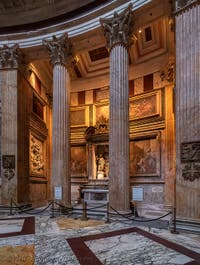Pantheon Art Story | Location | Opening Hours Tickets | Authorisations
Art Story Story | Porch Rotunda | Cupola | Basilica | Chapels Tombs
The Pantheon became Christian in the year 609
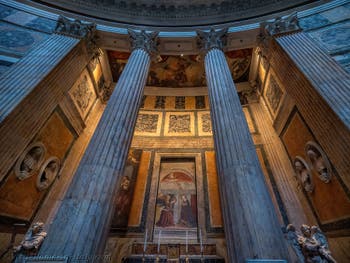
da Forli, Annunciation In 609, the government authorised Pope Boniface VI to transform the Pantheon into a Christian church and consecrate it.
This consecration meant that only the one God of Christians could be represented in the Pantheon.
The ancient Roman gods’ statues were removed or even destroyed.
The Pantheon changed its name and became the Basilica of Saint Mary among the Martyrs:
“Santa Maria ai Martiri”.

Assumption of the Virgin The disappearance of the ancient statues and the original decoration of the Pantheon is very regrettable; however, when it became a church, it remained a sacred building, which protected it from the looting and damage that it would have suffered as a Roman temple that had lost its religious vocation in a Rome that had become Christian.
Its transformation into a Christian place of worship required keeping it in good condition, so the vegetation beginning to cover it was removed, the water drains from the oculus were regularly cleaned and maintained, and everything was kept in a perfect state of cleanliness.
This allowed this extraordinary building to stand before us in perfect condition almost two thousand years after its construction.
The Pantheon stripped of its bronze
However, it has undergone a few vicissitudes over time.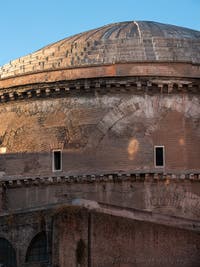
Outside of the Pantheon Thus, in 663, the Byzantine emperor Constantine II took off all the bronze that covered his dome; it is unknown what he did with it.
Later, the dome of the Pantheon was covered with lead plates to preserve its water tightness.
Emperor Constantine II was not the only one to steal bronze from the Pantheon: in 1620, Pope Urban VIII had nearly 200 tons of bronze removed from the roof structure of the porch, which was transformed into 80 cannons!
But this bronze was reused to create the superb bronze canopy in Saint Peter's Basilica in Rome.
The Pantheon, most celebrated monument in the world
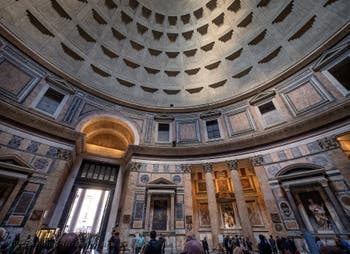
Cupola of the Pantheon Pope Urban VIII, although stripping the bronze of the porch, paid tribute to the Pantheon by having it engraved under the same porch and to the right of the front door in 1632:
“PANTHEON
AEDIFICIUM TOTO TERRARUM ORBE
CELEBERRIMVM”
“The Pantheon, the most celebrated monument in the world.”
We also know how much Michelangelo admired him, who described it as the work of angels and not that of men.
Lord Byron's Song to the Glory and Beauty of the Pantheon:
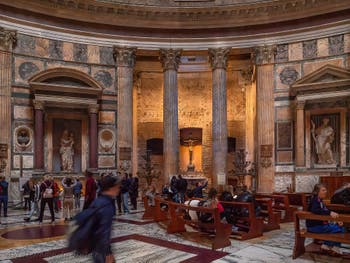
Madonna del Sasso
Simple, erect, severe, austere, sublime—
Shrine of all saints and the temple of all gods,
From Jove to Jesus—spared and blest by time;
Looking tranquillity, while falls or nods
Arch, empire, each thing round thee, and man plods
His way through thorns to ashes—glorious dome!
Shalt thou not last?—Time’s scythe and tyrants’ rods.
Shiver upon thee—sanctuary and home.
Of art and piety—Pantheon!
pride of Rome!
Relic of nobler days and noblest arts!
First Chapel of Pantheon Despoiled yet perfect, with thy circle spreads
A holiness appealing to all hearts—
To art a model; and to him who treads
Rome, for the sake of ages, Glory sheds.
Her light through thy sole aperture; to those
Who worship, here are altars for their beads;
And they who feel for genius may repose.
Their eyes on honoured forms, whose busts around them close.
Lord Byron. Childe Harold’s Pilgrimage. 1812.
The Pantheon today
The 1632 inscription of Pope Urban VIII remains current:“The Pantheon, the most celebrated monument in the world”
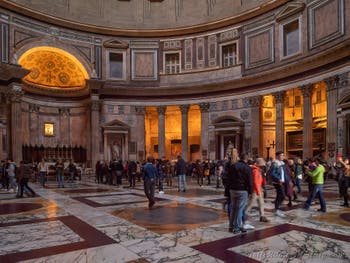
Madonna Cancellata The Pantheon is still a consecrated church where religious services are held, but you can visit it without difficulty, and admission is free.
Its atmosphere has not changed for two thousand years since the interior of the Pantheon, as it was just after its construction, is illuminated only by its large oculus in the centre of the dome.
You will therefore be able to feel all the beauty of this “celestial” ray of light that enters the rotunda and slides across the floor and walls throughout the day; no electric light will disturb your visit.
While the Roman statues of the pagan gods were removed in favour of the Christian god, they were replaced by statues made by the biggest names in Italian sculpture.
Likewise, you can admire several paintings and a 7th-century icon representing the Madonna and Christ placed above the main altar of the Pantheon.
Finally, you can only be amazed by the abundance of marble and granite that decorate the interior of the Pantheon and the superb Corinthian columns that frame each of the rotunda's chapels.
The Tomb of the Painter Raphael in the Pantheon
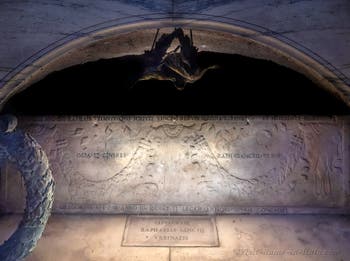
Sarcophagus Tomb of the Painter Raphael The painter Raphael was the first to be buried in the Pantheon.
On his tomb, we can read:
“There lay Raphael, who feared that nature would be overtaken while he lived, and when he died, she died with him.”
Raphael's tomb is located at the third aedicula of the Pantheon.
Tombs of the first two kings of Italy
The tombs of the first two kings of Italy are placed opposite each other in the Pantheon.Manfredo Manfredi designed the tomb of Vittorio Emanuele II, who died on June 9, 1878.
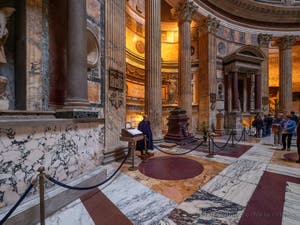
King Umberto I Grave The tomb of Victor Emmanuel II is located in the seventh chapel of the Pantheon.
Giuseppe Sacconi designed the tomb of Umberto I, who was assassinated in Monza on July 29, 1900.
Margaret of Savoy, the first queen of Italy and wife of Umberto I, who died in 1926, is buried next to her husband.
The tombs of Umberto I and Margherita di Savoia are located in the second chapel of the Pantheon.
Next Page: The Chapels and Aediculas of the Pantheon
Art Story Story | Porch Rotunda | Cupola | Basilica | Chapels Tombs
Pantheon Art Story | Location | Opening Hours Tickets | Authorisations
Back to Top of Page


